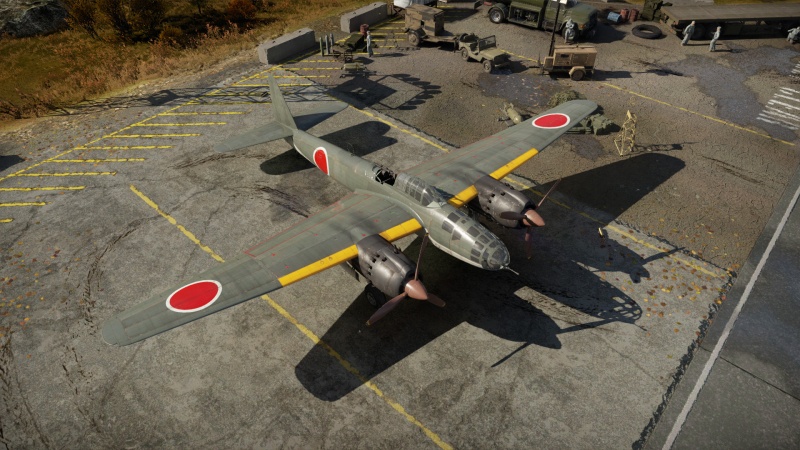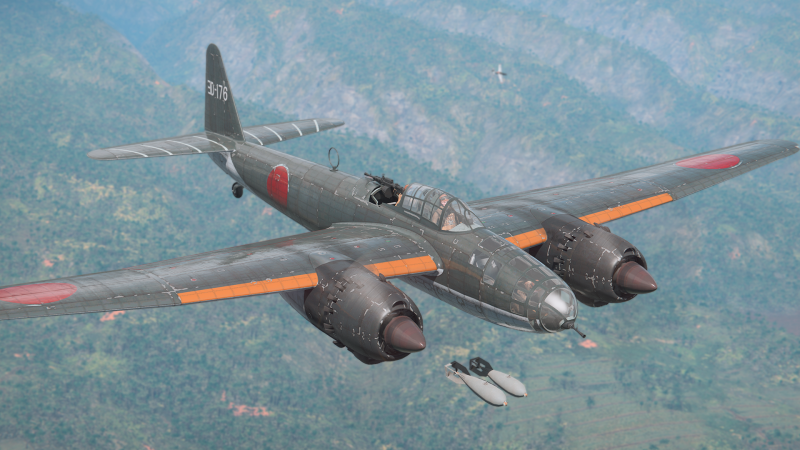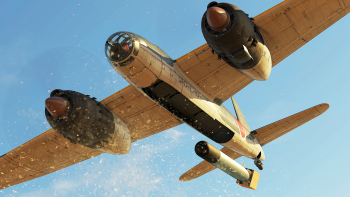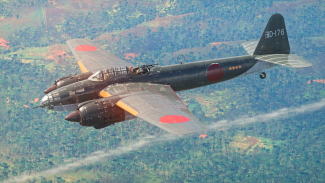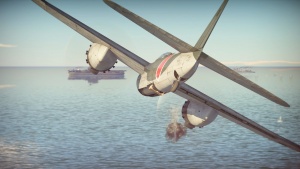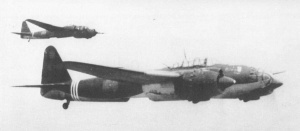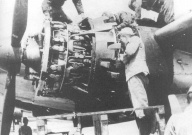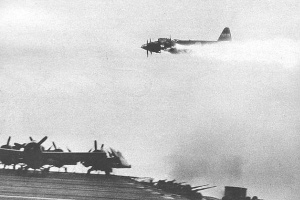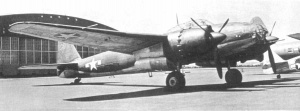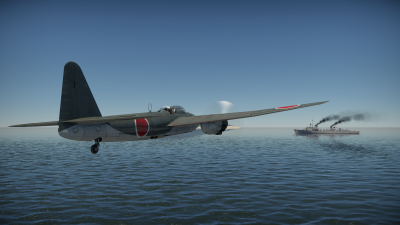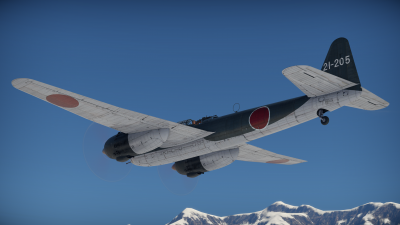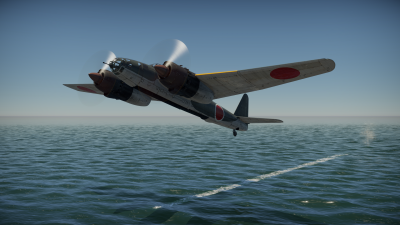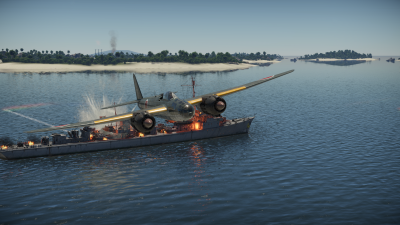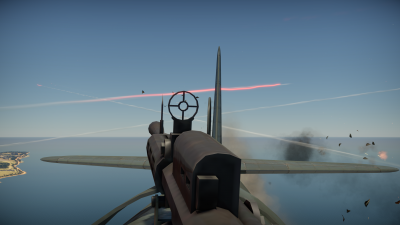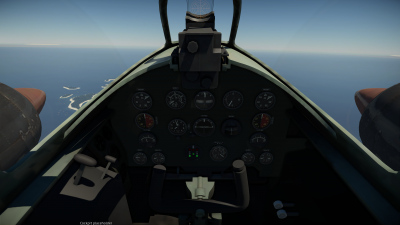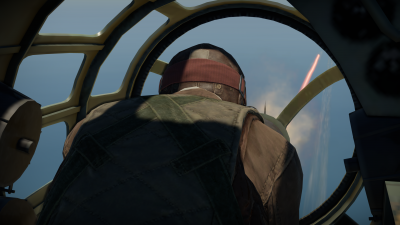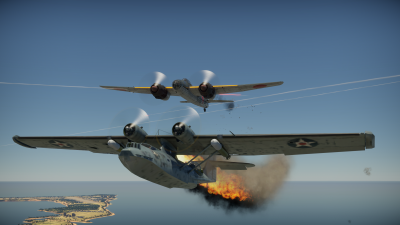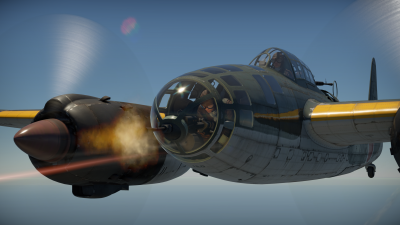P1Y1 mod. 11
| This page is about the Japanese dive bomber P1Y1 mod. 11. For the Chinese version, see P1Y1 mod. 11 (China). |
Contents
Description
The P1Y1 mod.11, designated as the Ginga 11 (銀河一一型), was a land-based long-range (dive-)bomber that was requested by the Japanese Navy after learning of the successes in the European theatres and out of their own experience with their own Type 96 G3Ms (and later Type 1 G4Ms) attack bombers lacking the ability to commit dive bombing actions. Initial development began by examining a purchased Ju 88 A with little real valuable lessons being drawn from the Ju 88 and development continued, with the last prototypes being rushed to be used in service production due to the lengthy development time and deterioration of the war situation. This resulted in a late-war multirole high-speed bomber that was troubled with maintenance and overall production numbers.
The Ginga was introduced in Update 1.63 "Desert Hunters". This bomber is one of the fastest at its battle rating and plays like the German Ju 288 C and Ar 234 B-2. The main strategy is to dive, release bombs, escape, and repeat. The P1Y1 can reach over 675 km/h (400 mph) in a dive, which outruns most fighters. However, the P1Y1 is also very fragile, with weak defensive guns and no turrets on the underside. This makes it vulnerable to attacks from below and to fighters that can catch up with it. The P1Y1 needs to rely on its speed and agility to evade enemies or seek friendly cover or the home base. If a heavier plane is chasing it, the P1Y1 can usually outturn it and make it lose energy and retreat. If a plane is behind its rear gunner, the gunner can fire and force the enemy to dodge and lose aim.
- Nicknames
- Official Designation: 銀河 (Ginga, "Galaxy")
- Allied reporting name: Frances.
- Initially incorrectly reported as a fighter: Francis
General info
Flight performance
The P1Y1 is a highly agile and fast aircraft. It can make sharp turns and can pull out of a dive quickly with the use of airbrakes. The airbrakes on this plane are extremely effective, but they take five seconds to deploy, so keep that in mind. The P1Y1 can also turn extremely well, although its roll rate is rather poor. The plane has good elevator authority, meaning it will be able to pull up very quickly. This is good for ground battles or naval battles. The performance of the P1Y1 is excellent. There is only one small flaw, and that is the P1Y1 locks up at redline speeds, so make sure to use those airbrakes!
| Characteristics | Max Speed (km/h at 5,900 m) |
Max altitude (metres) |
Turn time (seconds) |
Rate of climb (metres/second) |
Take-off run (metres) | |||
|---|---|---|---|---|---|---|---|---|
| AB | RB | AB | RB | AB | RB | |||
| Stock | 523 | 506 | 26.9 | 27.5 | 6.5 | 6.5 | 720 | |
| Upgraded | 573 | 546 | 25.7 | 26.0 | 15.2 | 10.2 | ||
Details
| Features | ||||
|---|---|---|---|---|
| Combat flaps | Take-off flaps | Landing flaps | Air brakes | Arrestor gear |
| ✓ | ✓ | ✓ | ✓ | X |
| Limits | ||||||
|---|---|---|---|---|---|---|
| Wings (km/h) | Gear (km/h) | Flaps (km/h) | Max Static G | |||
| Combat | Take-off | Landing | + | - | ||
| 431 | 405 | 275 | ~6 | ~3 | ||
| Optimal velocities (km/h) | |||
|---|---|---|---|
| Ailerons | Rudder | Elevators | Radiator |
| < 360 | < 360 | < 400 | > 301 |
Survivability and armour
- 7 mm Steel plate behind the pilot
- Self-sealing fuel tanks
The armour won't protect you, and fires are quite lethal, the self sealing fuel tanks don't always work. As usual, stay away from 50 cals!
Modifications and economy
The stock payload for the Ginga is poor, so rush all payload modules. The torpedo will be useful on Pacific maps to target destroyers. However, if cargo ships or pillboxes are present, the 500 kg bombs are your best bet.
Armaments
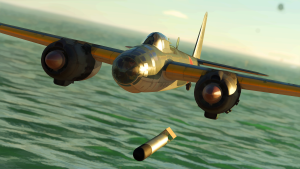
Suspended armament
The P1Y1 mod. 11 can be outfitted with the following ordnance:
- 2 x 250 kg Navy Type Number 25 Model 2 bombs (500 kg total)
- 1 x 850 kg Type 91 Model 3 torpedo
- 2 x 500 kg Navy Type Number 50 Model 2 bombs (1,000 kg total)
- 1 x 800 kg Number 80 Mod. 1 bomb (800 kg total)
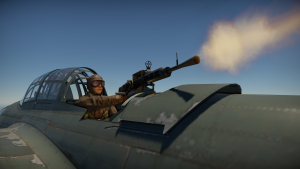
Defensive armament
The P1Y1 mod. 11 is defended by:
- 1 x 20 mm Type 99 Model 1 cannon, nose turret (225 rpg)
- 1 x 20 mm Type 99 Model 1 cannon, dorsal turret (225 rpg)
The 20 mm cannons on the Ginga are early Type 99 cannons, so they do not have good explosive filler. What's more is that the cannons are inaccurate, and have a low rate of fire. Do not expect to go kill anything with them. What you can do is use these cannons as a deterrent. You can outrun a P-51 using a special method that is known to Ginga pilots as "scrambling." Since the P1Y1 has a good top speed, you can show your rear of the aircraft to the approaching fighter. If they are catching up, dive. If you hit the deck and are cruising at ground level, you can force the enemy fighter to tail behind your 20 mm. This gives you a great shot at them, and it will most likely deter them.
Usage in battles
In Arcade battles, the light payload is somewhat countered by the ability to reload. It is recommended to use the plane to hit high-value targets such as pillboxes since it is limited to 2 bombs (though it is one of the few Japanese medium bombers able to carry 2 x 500 kg). Other planes with larger numbers of 60 kg bombs are better suited for taking out tanks and soft targets. It is at a huge disadvantage when compared to planes such as the B7A2, which has forward cannons able to strafe soft ground targets while bombs reload. As such, most pilots would use the B7A2 over the P1Y1, though this plane may still be useful in one's lineup for use after the B7A2 has been lost.
In Realistic tank battles, the best option is likely to take the 2 x 500 kg bomb option and again use its speed to quickly get in, hit 2 targets and run away before enemy fighters realize it is there and intercepts. Again, its speed should allow multiple runs somewhat making up for the light payload.
In Realistic battles, the main question is how to utilise this rather delicate aircraft effectively. The general tactic which provides the most effective outcome is to use this aircraft as a ground pounder. The most effective targets for this aircraft will be pillboxes, vehicles and anti-aircraft artillery. Leave the dogfighting, bomber hunting and base bombing for the arcade battles. This is for a number of reasons, the first being the Ginga's payload which consists of only one 800 kg bomb or two 500 kg bombs. That being said, this measly amount barely has enough destructive power to destroy half a base. Instead, pillboxes will provide excellent sources of research points and will bleed enemy tickets. To kill pillboxes, take the 500 kg bombs with a two-second fuse. To set up a run, you will need to dive as soon as the match starts and need to be as close to the ground as possible to accurately bomb the pillboxes. Try to drop the bomb just a little before the crosshair, due to a slight delay in the bomb drop. This shouldn't be too noticeable, so just remember to release the bombs a little before you typically would release them. After destroying two pillboxes, destroy lightly armoured targets with your turrets, or, if there are enemy fighters inbound, go in a straight line for your home base and keep your speed high. Reload, repair, and get back out on the next target! The Ginga can make many bombing runs in one match thanks to its speed.
Unfortunately, there might be a problem on Pacific maps as carrier landings in the P1Y1 are tricky. If the carrier is moving, your option is to try to land on it. Drop your speed to around 165 km/h (100 mph), with landing flaps and gear, but without airbrakes. Next, land on the very edge of the carrier and retract flaps and use airbrakes. If you break a wing on the tower, it should stop and repair you. However, if the carrier isn't moving the safest option is to belly land. Try going as slow as possible and try to land flat, not tail first. Snapping a wing on the tower is a good idea because it will aid in bringing you to a full stop.
Manual Engine Control
| MEC elements | ||||||
|---|---|---|---|---|---|---|
| Mixer | Pitch | Radiator | Supercharger | Turbocharger | ||
| Oil | Water | Type | ||||
| Controllable | Controllable Not auto controlled |
Controllable Auto control available |
Controllable Auto control available |
Separate | Controllable 2 gears |
Not controllable |
The Ginga has solid engines, providing a maximum combined 3,662 units of horsepower on takeoff. They also come with a two-stage supercharger. The propeller pitch should be used at 90%-100% when on WEP. Lower the propeller pitch to 90% when at high speeds. The radiators can be kept at 10-20%, and the supercharger can be activated at 3.5 km (11k ft), and the mixture can be set to the following at each specific altitude:
- Sea Level: 100%-110% Mixture
- 3,000 feet: 92% Mixture
- 6,000 feet: 84% Mixture
- 10,000 feet: 70% Mixture
- 15,000 feet: 60% Mixture
Pros and cons
Pros:
- Very fast & surprisingly manoeuvrable
- 20 mm turrets quickly destroy fighters when they hit
- Has really effective airbrakes
- Its speed forces enemies to tail you in line with your rear gunner
- Bomber air spawn
- Self-sealing fuel tanks can sometimes extinguish fires
- Can carry the Type 91 Mod. three torpedoes, the best torpedo in the game
Cons:
- No fixed forward armament
- Payload is limited to 2 x 500 kg or 800 kg max
- No tail hook, you might have trouble landing on pacific maps
- Forward turret has a very limited firing arc, and AI gunner rarely engages
- Easy to set ablaze, 50/50 chance of surviving
- Long gunner reload time
- Inaccurate and slow firing 20 mm turrets
History
The P1Y1 Ginga (銀河, Galaxy/Milky Way) was a Japanese twin-engine bomber that was the direct successor over the G4M developed by the Naval Air Technical Arsenal in Yokosuka. The allied reporting name for the Ginga would become Frances, after it was initially misreported for a fighter and given a male name beforehand: Francis.
Development
During 1939, the navy considered it to be more desirable to deploy more large dive bombers as they experienced the war in China. This vision was also helped with the great success of fast bomber planes such as the Ju 88 in the European front. With great interest in expanding the bomber arsenal, the navy shipped over a Ju 88A from Germany for evaluation and started working on the 15-Shi Twin-Engine Land Bomber. On further investigation, the technology that came with the Junkers plane didn't exactly benefit towards the development of the 15-Shi which had the requirements as followed:
Cruising range ≥ Regular navy bomber range (~5,556 km) Speed ≥ A6M speeds (511 km/h) Bomb capability = Bombing runs and dive bombing strikes with 1 ton Dive speed ≥ Limit of 648 km/h Take-off Distance ≤ 600 m
By the standards of Japanese plane naming after 1942, the 15-Shi was to be designed in the role of a dive-bomber, classed as "Bomber", instead of a torpedo bomber, classed as "Attacker" which was initially not planned to have. Therefore the plane would be named Ginga (銀河, Galaxy) as other dive-bombers getting names of star or constellation bodies.
Operational history
- Prototype towards mass production
The first prototypes of the 15-Shi would be completed in June 1942, it reached a maximum speed of 566 km/h at 5,500 m altitude, cruising range of 5,371 km and a maximum diving speed of 703 km/h which exceeded the Navy's requirements. With the war worsening, the production lines were rushed and tests were conducted later in 1943. Full-scale production of the 15-Shi began in November of the same year.
- Usage
The 15-Shi would be officially adopted as the P1Y1, Ginga model 11 in October of 1944, and the first Kōkūtai (Air Group) would be the 521th Kōkūtai which would see the Ginga used in the Battle of the Philippine Sea and the New Guinea Campaign but would see unfavourable results with the growing strength of the US Navy and losing air and naval control of the Japanese Navy.
Nakajima manufactured 1,002 examples, which were put into initial use by a total of five Kōkūtai's totalling up to around 30 air groups near the end, and acted as land-based medium and torpedo bombers from airfields in China, Formosa (Taiwan), the Mariana Islands, the Philippines, the Ryukyu Islands, Shikoku, and Kyūshū.
During the battle for Formosa (Taiwan), four Gingas of the 762nd Kōkūtai struck the USS Houston (CL-81) with three P1Y1s getting intercepted on the night of October 14, 1944. One of the torpedoes hit the Houston and caused it to start flooding and had to retreat and would not return until the end of the war together with the USS Canberra (CA-70) which was heavily damaged as well by a torpedo strike the day before.
During the last stages of the war, the P1Y was used as a kamikaze aircraft against the United States Navy during the Okinawa Campaign in Operation Tan No. 2. In that operation an Essex-class carrier, USS Randolph would be hit by a P1Y in the stern. Next to the 26 deaths and ~100 casualties, Randolph would be in action rather quickly and would be able to take part in the battle of Okinawa.
- USS Franklin (CV-13)
One other known "successful" use of a P1Y1 was a single Ginga striking an Essex-class carrier, the USS Franklin, and single-handedly caused the most severe damage and highest casualties experienced by any US fleet carrier that survived World War II.
The Franklin was within 80 km of the Japanese mainland, closer than any other US carrier during the war and had fighter squadrons up and strikes against shipping in Kure Harbor. The Ginga on its own managed to approach the Franklin without being detected, pierced through the clouds and dived upon the Franklin just as a second wave of aircraft were about to launch. the P1Y1 dropped two 250 kg semi-armour piercing bombs before getting shot down or escaping, it's unclear if the Ginga actually made it out or got shot down due conflicting accounts.
One of the bombs struck the flight deck centerline, penetrating to the hangar deck, causing major damage and igniting fires through the second and third deck together with knocking out CIC and air plot. The second hit aft, tearing through two decks. At the time she was struck, Franklin had 31 armed and fuelled up F4Us on flight deck and these caught fire almost immediately after the bombs. All the ordnance these F4Us were packing which was around 13 to 16 tons of high explosives started detonating progressively, but the individually heaviest ordnance being the "Tiny Tim" rockets would fly overboard due their engines being ignited and the planes pointing nose up, which allowed them to not explode on deck.
- Postwar
At the end of the war, American intelligence collected three P1Y1's and sent them over to the United States for evaluation. They were later identified as FE Foreign Equipment number 1700, FE 1701 and FE 1702. The USAAF based FE 1702 at Olmstead Field a Military Air Transport Service Command depot in Middletown, Pennsylvania. At Olmstead, guest pilots evaluated and flew the aircraft. History on these 3 P1Y's during the war is currently still unknown.
FE 1702 would become the last public available P1Y and is currently in hold of the Smithsonian's Paul Garber Facility of its National Air and Space Museum. The USAAF transferred the FE 1702 to the Smithsonian Institution in September of 1948. In January 1949, the air force shipped the P1Y1 to Chicago Orchard Airport, Park Ridge, Illinois, a temporary storage facility for aircraft and related artifacts. The National Air Museum transferred the Frances to the storage site at Suitland, Maryland, sometime during the 1950s.
The fuselage of FE 1702 has been put on display before without wings & engines, but the wings and engines are confirmed to still exist within storage. Currently it's disassembled and kept in storage.
Variants
Main Line:
- P1Y1, 15-Shi land bomber
- P1Y1, Ginga Model 11
- P1Y1a, Ginga Model 11 Ko - ((Tail) 20 mm replaced with 13 mm)
- P1Y1b, Ginga Model 11 Otsu - ((Tail) 13 mm replaced with twin 13 mm)
- P1Y1c, Ginga Model 11 Hei - ((Nose) 20 mm replaced with 13 mm)
- P1Y1 Ground attack variant - ((Bomb-bay) 20 mm x 20 mm)
- P1Y2, Ginga Model 16 - Converted from P1Y2-S (Mitsubishi Kasei 25 Kō engines)
- P1Y2a, Ginga Model 16 Ko - Converted from P1Y1a ((Tail) 20 mm replaced with 13 mm)
- P1Y2b, Ginga Model 16 Otsu - Converted from P1Y1b ((Tail) 13 mm replaced with twin 13 mm)
- P1Y2c, Ginga Model 16 Hei - Converted from P1Y1c ((Nose) 20 mm replaced with 13 mm)
- P1Y3, Ginga Model 33 - Converted from P1Y1 (Nakajima Homare 21 engines)
- P1Y4, Ginga Model 12 - Converted from P1Y1 (Nakajima Homare 23 engines)
- P1Y5, Ginga Model 14 - Converted from P1Y1 (Mitsubishi Ha-43 engines)
- P1Y6, Ginga Model 17 - Converted from P1Y1 (Mitsubishi Kasei 25 Hei engines)
- Tenga - Proposed jet-powered bomber variant
Night fighter conversion:
- P1Y1-S, Kyokko Model 21 - (Radar + 4 x 20 mm Schräge Musik)
- P1Y2-S, Kyokko Model 26 - (Armed with 2 x 20's and 1 x 30 mm)
Media
- Skins
- Images
- Videos
See also
- G4M1 - The predecessor to the P1Y1
- T18B-1 - A Swedish Torpedo bomber with two engines
- Do 217 K-1 - A German twin-engine torpedo bomber
- B7A2 - A more practical Japanese torpedo bomber
External links
| Yokosuka Naval Air Technical Arsenal (海軍航空技術廠) | |
|---|---|
| Bombers | D4Y1 · D4Y2 · D4Y3 Ko |
| P1Y1 mod. 11 | |
| Jet fighters | R2Y2 Kai V1 · R2Y2 Kai V2 · R2Y2 Kai V3 |
| Captured | ␗P1Y1 mod. 11 |
| While the arsenal was simply known as the Naval Air Technical Arsenal and usually referred to as Kūgi-shō (Kaigun Kōkū Gijutsu-shō). | |
| The name Yokosuka prevailed however, even though it referred to the Arsenal's location. | |
| See also | Yokosuka Naval Arsenal (Shipyard) |
| Japan bombers | |
|---|---|
| Navy | |
| Carrier-based attack bomber | |
| B5N | B5N2 |
| B6N | B6N1 · B6N2 · B6N2a |
| B7A | B7A2 · B7A2 (Homare 23) |
| Carrier-based dive bomber | |
| D3A | D3A1 |
| D4Y | D4Y1 · D4Y2 · D4Y3 Ko |
| Shipboard Observation seaplane | |
| F1M | F1M2 |
| Land-based Attack bomber | |
| G4M | G4M1 |
| G5N | G5N1 |
| G8N | G8N1 |
| Flying boat | |
| H6K | H6K4 |
| H8K | H8K2 · H8K3 |
| Land-based Bomber | |
| P1Y | P1Y1 |
| Army | |
| Light | Ki-32 |
| Ki-48-II otsu | |
| Heavy | Ki-21-Ia · Ki-21-I hei |
| Ki-49-I · Ki-49-IIa · Ki-49-IIb · Ki-49-IIb/L | |
| Ki-67-I Ko · Ki-67-I otsu | |
| Other countries | ▅B-17E |



